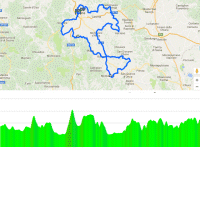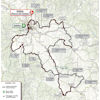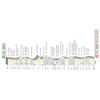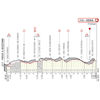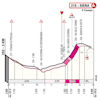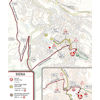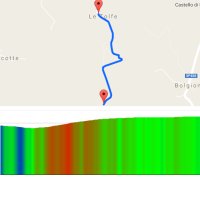The riders tackle eleven sectors and 63 kilometres on iconic Tuscan gravel, or ‘sterrati’ as the locals prefer to say. The first one is a solid way to get warmed up to the hardships ahead. It’s 2.1 kilometres long and perfectly straight.
Sector 2 does give the pilots a more accurate taste of what’s ahead. After 5.8 kilometres on gravel and steepest ramps at 10%, smooth asphalt returns at kilometre 32.
Following two flat to descending dirt roads – respectively 4.4 and 5.5 kilometres – the Strade Bianche tackles its second climb. This one is on tarmac and leads to the fortified town of Montalcino, where the Giro d’Italy will finish this May after a Strade Bianche-ish stage.
On to sterrato 5. An enchanting dust road in itself, with fields and forest left and right, this is – at 11.9 kilometres – the longest sector of the day. Moreover, after just 1 kilometre of tarmac the 6th gravel road brings something extra to the mix. At 8 kilometres, it runs on winding roads and includes both climbing and descending.
By now, the riders are halfway. In last year’s summer edition this was a pre-decisive phase with Jakob Fuglsang, Alberto Bettiol, Wout van Aert, Davide Formolo, Greg Van Avermaet and Maximilian Schachmann distancing the other contenders.
Sector 7 is 9.5 kilometres long and runs mostly uphill. It goes up and down in the first part and ends with a twisting climb before meeting the tarmac again.
At kilometre 130 the endgame begins on the Monte Sante Marie climb. At 11.5 kilometres, sector 8 is arguably the toughest of all sterrati at the Strade Bianche. With a lot of uphill the strip also features some tricky descents.
Following a lumpy intermezzo on smooth asphalt – which may sound better than it actually is – the riders tackle the first of the last three unpaved sectors. Sterrato 9 is 800 metres long and pepped up with a double digit gradient ramp before hitting the tarmac again in Vico d’Arbia.
A rolling stretch continues onto the Strade di Colle Pinzuto, which is a 2.4 kilometres sector that will weary the legs still further. It begins with a 15% ramp and keeps climbing gradually all the way until the end.
The final gravel road is a 1.1 kilometres toil, opening with a short descent and closing with 18% gradients. Van Aert shook off his last rivals at this sector to continue solo to the finish line.
When Strade Bianche reaches the village of Le Tolfe there are still 12 kilometres to go. The winding roads of Tuscany favour attackers in this phase, as chasers will have difficulty pinpointing them.
With 5 kilometres remaining the road flies downhill, only to go back up again in the last kilometre. Entering the city walls of Siena, a 16% sector welcomes the riders. A sharp turn to the right, left, and right again. The finish is at Piazza del Campo, Siena’s iconic square resembling a theatre.
Another interesting read: results Strade Bianche 2021.
Strade Bianche 2021: routes, profiles, more
Click on the images to zoom
